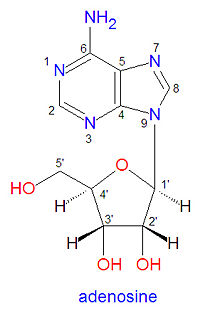Adenosine: Difference between revisions
imported>Robert Badgett m (→Clinical role) |
imported>Howard C. Berkowitz mNo edit summary |
||
| Line 10: | Line 10: | ||
|molmass= | |molmass= | ||
|uses= RNA | |uses= RNA | ||
|properties=nucleic acid | |properties=nucleic acid | ||
|hazards= | |hazards= | ||
|iupac= | |iupac= | ||
Revision as of 18:33, 19 August 2010
|
| |||||||
| adenosine | |||||||
| |||||||
| Uses: | RNA | ||||||
| Properties: | nucleic acid | ||||||
| Hazards: | |||||||
| |||||||
Adenosine, is one of the nucleotides used to build RNA. It is also incorporated into DNA, but in DNA the ribose ring is a 2'-deoxyribose ring. In both DNA and RNA, adenosine is linked to the other nucleotides by phosphodiester bonds at both the 3'- and 5'- positions. In duplex DNA, the adenine base present in adenosine is hydrogen bonded with, that is, it forms a base pair with, a thymidine nucleotide on the opposite DNA strand.
Nomenclature
The structure of adenosine contains two distinct parts, the adenine base and the ribose sugar ring. Because of this, RNA and DNA nomenclature use numbers to describe atoms that are on the base ring while using primed numbers to describe atoms on the ribose ring (see figure). In DNA the 2'-carbon of adenosine is bound to two hydrogen atoms rather than one proton and one hydroxyl group.
Clinical role
Adenosine inhibits the effects intracellular cyclic AMP thus reducing sympathetic stimulation.[1]
The drug dipyridamole potentiates adenosine.
The methylxanthines caffeine and theophylline block adenosine receptors leading to increased sympathetic stimulation.[1]
References
- ↑ 1.0 1.1 Keith Parker; Laurence Brunton; Goodman, Louis Sanford; Lazo, John S.; Gilman, Alfred (2006). “Chapter 34. Antiarrhythmic Drugs”, Goodman & Gilman's the pharmacological basis of therapeutics, 11th. New York: McGraw-Hill. ISBN 0-07-142280-3.
